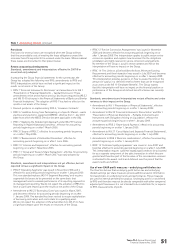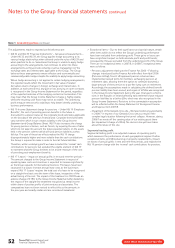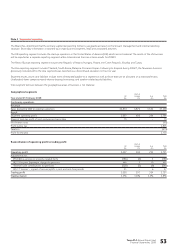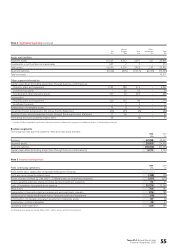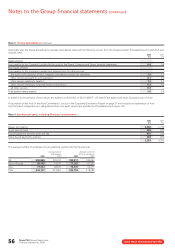Tesco 2008 Annual Report Download - page 49
Download and view the complete annual report
Please find page 49 of the 2008 Tesco annual report below. You can navigate through the pages in the report by either clicking on the pages listed below, or by using the keyword search tool below to find specific information within the annual report.
Tesco PLC Annual Report and
Financial Statements 2008 47
Clubcard and loyalty initiatives
The cost of Clubcard is treated as a cost of sale, with an accrual equal to
the estimated fair value of the points issued recognised when the original
transaction occurs. On redemption, the cost of redemption is offset against
the accrual.
The fair value of the points awarded is determined with reference to the
cost of redemption and considers factors such as redemption via Clubcard
deals versus money-off in-store and redemption rate.
Computers for Schools and Sport for Schools and Clubs vouchers are
issued by Tesco for redemption by participating schools/clubs and are part
of our overall Community Plan. The cost of the redemption (i.e. meeting
the obligation attached to the vouchers) is treated as a cost rather than
as a deduction from sales.
Other income
Finance income is recognised in the period to which it relates on an
accruals basis. Dividends are recognised when a legal entitlement to
payment arises.
Operating profit
Operating profit is stated after profit arising on property-related items but
before the share of results of joint ventures and associates, finance income
and finance costs.
Discontinued operations
A discontinued operation is a component of the Group’s business that
represents a separate line of business or geographical area of operation.
Classification as a discontinued operation occurs upon disposal or earlier,
if the operation meets the criteria to be classified as held for sale, under
IFRS 5 ‘Non-current assets held for sale’.
Property, plant and equipment
Property, plant and equipment assets are carried at cost less accumulated
depreciation and any recognised impairment in value.
Property, plant and equipment assets are depreciated on a straight-line
basis to their residual value over their anticipated useful economic lives.
The following depreciation rates are applied for the Group:
> Freehold and leasehold buildings with greater than 40 years unexpired –
at 2.5% of cost;
> Leasehold properties with less than 40 years unexpired are depreciated
by equal annual instalments over the unexpired period of the lease; and
> Plant, equipment, fixtures and fittings and motor vehicles – at rates
varying from 9% to 33%.
Assets held under finance leases are depreciated over their expected useful
lives on the same basis as owned assets or, when shorter, over the term of
the relevant lease.
All tangible fixed assets are reviewed for impairment in accordance with
IAS 36 ‘Impairment of Assets’ when there are indications that the carrying
value may not be recoverable.
Borrowing costs
Borrowing costs directly attributable to the acquisition or construction of
qualifying assets are capitalised. Qualifying assets are those that necessarily
take a substantial period of time to prepare for their intended use. All other
borrowing costs are recognised in the Group Income Statement in the
period in which they occur.
Investment property
Investment property is property held to earn rental income and/or for
capital appreciation rather than for the purpose of Group operating
activities. Investment property assets are carried at cost less accumulated
depreciation and any recognised impairment in value. The depreciation
policies for investment property are consistent with those described for
owner-occupied property.
Leasing
Leases are classified as finance leases whenever the terms of the lease
transfer substantially all the risks and rewards of ownership to the lessee.
All other leases are classified as operating leases.
The Group as a lessor
Amounts due from lessees under finance leases are recorded as receivables
at the amount of the Group’s net investment in the leases. Finance lease
income is allocated to accounting periods so as to reflect a constant
periodic rate of return on the Group’s net investment in the lease.
Rental income from operating leases is recognised on a straight-line basis
over the term of the relevant lease.
The Group as a lessee
Assets held under finance leases are recognised as assets of the Group
at their fair value or, if lower, at the present value of the minimum lease
payments, each determined at the inception of the lease. The corresponding
liability is included in the Group Balance Sheet as a finance lease obligation.
Lease payments are apportioned between finance charges and reduction
of the lease obligations so as to achieve a constant rate of interest on the
remaining balance of the liability. Finance charges are charged to the
Group Income Statement.
Rentals payable under operating leases are charged to the Group Income
Statement on a straight-line basis over the term of the relevant lease.
Sale and leaseback
A sale and leaseback transaction is one where a vendor sells an asset and
immediately reacquires the use of that asset by entering into a lease with
the buyer. The accounting treatment of the sale and leaseback depends
upon the substance of the transaction (by applying the lease classification
principles described above) and whether or not the sale was made at the
asset’s fair value.
For sale and finance leasebacks, any apparent profit or loss from the
sale is deferred and amortised over the lease term. For sale and operating
leasebacks, generally the assets are sold at fair value, and accordingly the
profit or loss from the sale is recognised immediately.
Following initial recognition, the lease treatment is consistent with those
principles described above.
Note 1 Accounting policies continued
















